
Haiti, officially the Republic of Haiti, is a country on the island of Hispaniola in the Caribbean Sea, east of Cuba and Jamaica, and south of The Bahamas. It occupies the western three-eighths of the island, which it shares with the Dominican Republic. Haiti is the third largest country in the Caribbean, and with an estimated population of 11.4 million, is the most populous Caribbean country. The capital and largest city is Port-au-Prince.
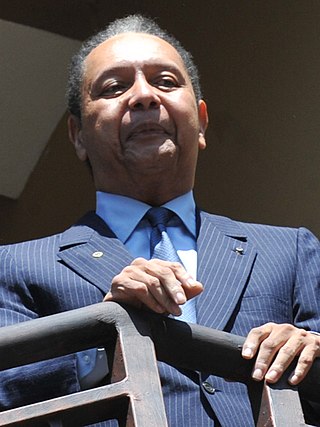
Jean-Claude Duvalier, nicknamed "Baby Doc", was a Haitian politician who was the President of Haiti from 1971 until he was overthrown by a popular uprising in February 1986. He succeeded his father François "Papa Doc" Duvalier as the ruler of Haiti after his death in 1971. After assuming power, he introduced cosmetic changes to his father's regime and delegated much authority to his advisors. Thousands of Haitians were tortured and killed, and hundreds of thousands fled the country during his presidency. He maintained a notoriously lavish lifestyle while poverty among his people remained the most widespread of any country in the Western Hemisphere.

The boll weevil is a species of beetle in the family Curculionidae. The boll weevil feeds on cotton buds and flowers. Thought to be native to Central Mexico, it migrated into the United States from Mexico in the late 19th century and had infested all U.S. cotton-growing areas by the 1920s, devastating the industry and the people working in the American South. During the late 20th century, it became a serious pest in South America as well. Since 1978, the Boll Weevil Eradication Program in the U.S. allowed full-scale cultivation to resume in many regions.
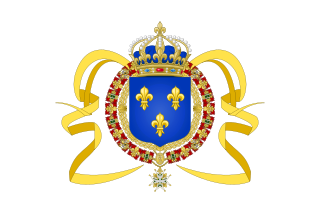
Saint-Domingue was a French colony in the western portion of the Caribbean island of Hispaniola, in the area of modern-day Haiti, from 1697 to 1804. The name derives from the Spanish main city on the island, Santo Domingo, which came to refer specifically to the Spanish-held Captaincy General of Santo Domingo, now the Dominican Republic. The borders between the two were fluid and changed over time until they were finally solidified in the Dominican War of Independence in 1844.
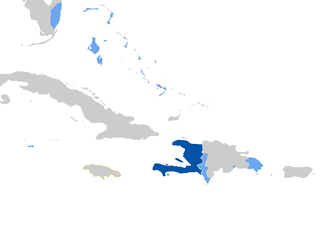
Haitian Creole, or simply Creole, is a French-based creole language spoken by 10 to 12 million people worldwide, and is one of the two official languages of Haiti, where it is the native language of the vast majority of the population. Northern, Central, and Southern dialects are the three main dialects of Haitian Creole. The Northern dialect is predominantly spoken in Cap-Haïtien, Central is spoken in Port-au-Prince, and Southern in the Cayes area.
Classical swine fever (CSF) or hog cholera is a highly contagious disease of swine. It has been mentioned as a potential bioweapon.
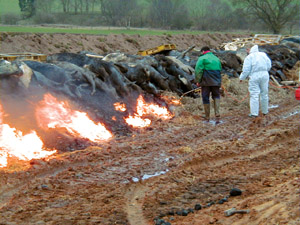
The outbreak of foot-and-mouth disease in the United Kingdom in 2001 caused a crisis in British agriculture and tourism. This epizootic saw 2,000 cases of the disease on farms across most of the British countryside. Over 6 million cows and sheep were slaughtered on farms in an eventually successful attempt to halt the disease. Cumbria was the worst affected area of the country, with 893 cases.
Mission Zamora is an integrated land reform and land redistribution program in Venezuela, created in law by the Ley de Tierras, part of a package of 49 decrees made by Hugo Chávez in November 2001. The plan is named in honor of Ezequiel Zamora, a 19th-century Venezuelan peasant leader.

African swine fever virus (ASFV) is a large, double-stranded DNA virus in the Asfarviridae family. It is the causative agent of African swine fever (ASF). The virus causes a hemorrhagic fever with high mortality rates in domestic pigs; some isolates can cause death of animals as quickly as a week after infection. It persistently infects its natural hosts, warthogs, bushpigs, and soft ticks of the genus Ornithodoros, which likely act as a vector, with no disease signs. It does not cause disease in humans. ASFV is endemic to sub-Saharan Africa and exists in the wild through a cycle of infection between ticks and wild pigs, bushpigs, and warthogs. The disease was first described after European settlers brought pigs into areas endemic with ASFV, and as such, is an example of an emerging infectious disease.

Antoine Louis Léocardie Élie Lescot was the President of Haiti from May 15, 1941 to January 11, 1946. He was a member of the country's mixed-race elite. He used the political climate of World War II to sustain his power and ties to the United States, Haiti's powerful northern neighbor. His administration presided over a period of economic downturn and harsh political repression of dissidents. He was the last Haitian head of state to have been born in the 19th century.
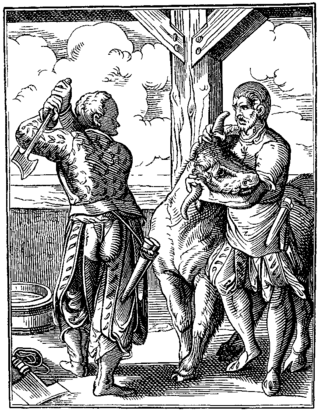
Animal slaughter is the killing of animals, usually referring to killing domestic livestock. It is estimated that each year, 80 billion land animals are slaughtered for food. Most animals are slaughtered for food; however, they may also be slaughtered for other reasons such as for harvesting of pelts, being diseased and unsuitable for consumption, or being surplus for maintaining a breeding stock. Slaughter typically involves some initial cutting, opening the major body cavities to remove the entrails and offal but usually leaving the carcass in one piece. Such dressing can be done by hunters in the field or in a slaughterhouse. Later, the carcass is usually butchered into smaller cuts.
The Program to Eradicate African Swine Fever and to Develop Pig Raising was a development project which took place in Haiti in the 1980s. It was launched in 1981 by the Food and Agriculture Organization of the United Nations; the Instituto Interamericano de Ciencias Agrícolas (IICA), a branch of the Organization of American States; the International Development Bank; the governments of Mexico, Canada, the United States; and the government of Haiti to "eliminate the debilitating effects of African swine fever (ASF) in Haiti and to begin development of a productive swine industry".
The 1967 United Kingdom foot-and-mouth outbreak was a major outbreak of foot and mouth disease in the United Kingdom. The only centre of the disease, in contrast to the three concentrated areas in the 2001 crisis, was on the Wales border with Shropshire. France and other European countries were also affected by the crisis.

Social class in Haiti is defined by a class structure that groups people according to wealth, income, education, type of occupation, and membership in a specific subculture or social network. Race has also played an important factor in determining social class since the colonial period (1625–1804) when Haiti was the French colony of Saint-Domingue.

Agriculture in Haiti describes the tortured agricultural history of an island nation once described as the "Pearl of the Antilles". The Taíno people were the farming inhabitants of the island when the Spanish first visited in the late 15th century. The Taino died out from European diseases and exploitation and were replaced with imported African slaves. In the 18th century, Haiti became a country of large plantations, especially of sugar cane, owned by Europeans and worked by hundreds of thousands of slaves. The slaves revolted in 1791 and gained independence from France. The plantations were broken up and the land was distributed to former slaves who primarily engaged in subsistence agriculture with coffee as their most important cash crop and as Haiti's most important export.

Foot-and-mouth disease (FMD) or hoof-and-mouth disease (HMD) is an infectious and sometimes fatal viral disease that affects cloven-hoofed animals, including domestic and wild bovids. The virus causes a high fever lasting two to six days, followed by blisters inside the mouth and near the hoof that may rupture and cause lameness.
In reaction to the 2009 flu pandemic, governments around the world had responded with countermeasures, some with extreme actions against pigs, which included the official extermination of all domestic pigs in Egypt and the culling of three wild boars at the Baghdad Zoo in Iraq. Many of these slaughters occurred in Muslim countries, and religious restrictions on the consumption of pork have been cited as influencing the decision to take such action. Many other countries had also banned international trade in pigs and pork products.
Vesicular exanthema of swine virus (VESV) is a virus which produces a disease in pigs that is clinically indistinguishable from the viruses causing foot-and-mouth disease (FMD) and swine vesicular disease (SVD). VESV affects only pigs and marine mammals. It is not transmissible to humans.

The Duvalier dynasty was an autocratic hereditary dictatorship in Haiti that lasted almost 29 years, from 1957 until 1986, spanning the rule of the father-and-son duo Dr. François Duvalier and Jean-Claude Duvalier.
Rice production was an integral part of the Haitian economy, as it has been farmed in Haiti for over two hundred years. The origin of this rice has been traced back to West African agriculture. Rice is a staple food for most Haitians but it has become a commodity in the sense that Haiti is no longer self-sufficient in producing rice for the country. Haiti maintained dependency on their own agriculture of rice until the 1980s. In the mid-1980s trade liberalization policies imposed by international financial institutions resulted in reduced production of rice in Haiti and by the 1990s imported rice far exceeded domestic production. The decline in rice production caused by policies under the Caribbean Basin Initiative had devastating consequences for Haiti's rural population. Many Haitian farmers, traders, and millers faced unemployment and relocation. Because farming was their livelihood, many could not find adequate work with their skill set. The adoption of trade liberalization policies and environmental degradation are said to be the two factors that have caused Haiti's decline in rice production. These policies have lowered the rice import tariff so that it is now less than any other Caribbean nation. The tariff is at three percent, causing a dumping ground of rice in Haiti. Many accuse the United States of purposefully depositing all of their rice into Haiti; in 1985 the local rice production was at 163,296 metric tons while the United States imports were only at 7,337 metric tons counting for a total of 170,663 metric tons. By 2000, local production had decreased to 130,000 metric tons while United States imports ascended to 219,590 metric tons; in addition, since 1995 over $13 billion in subsidies have gone to rice exports. The result made Haiti inundated with subsidized rice imports while undercutting domestic production.













